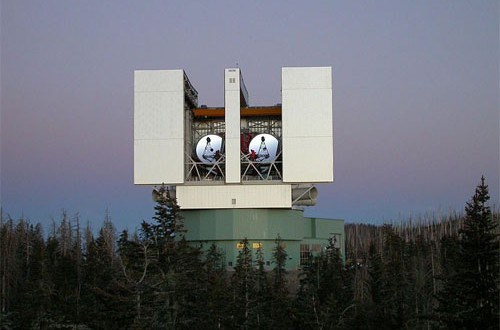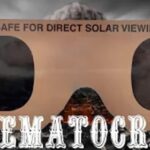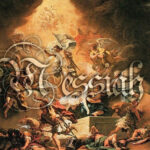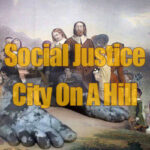…Including One Named L.U.C.I.F.E.R.?
PlaneTruth | (Abridged)
The dedication plaque of the VATT reads:
This new tower for studying the stars has been erected during the XV year of the reign of John Paul II on this peaceful site so fit for such studies, and it has been equipped with a new large mirror for detecting the faintest glimmers of light from distant objects. May whoever searches here night and day the far reaches of space use it joyfully with the help of God.
The Vatican’s latest ….The L.U.C.I.F.E.R. Telescope
A key to understanding how long the myth of a global heliocentric, agnostic, universe has been perpetuated on all is to understand how long and deep the Vatican has been involved with observing the heavens all the way back to Copernicus, (who himself became a catholic priest in the last years of his life and studied cannon law).
Through owning all of the information coming from the heavens, along with NASA, they been able to steer and control the narratives that we all learn about what is, and has been going on in our universe.
These narratives have included controlled opposition stories of scientific breakthroughs by Copernicus, Newton, Kepler and Galileo who all had their findings vetted through the Royal Society of England, who validated scientific theory through the 19th century, as well as the Vatican.
The Vatican also owns most of the early books of antiquity on astronomy as well as owning the most patents on celestial observatories. Strange for an organization who was adamant of a geocentric universe.
Why would they set up the earliest observatories right at the end of the Dark Ages, that continues to this day some 500 years later, if they were so dead set on maintaining that the Earth was the center of the universe?
They allegedly crucified and burned at the stake heretics like Bruno, and exiled Galileo, for their trying to prove that the Sun was center of our solar system, not the Earth. And the story goes that Copernicus waited until on his death-bed before publishing the work that changed everything we knew about our relation to the universe, On the Revolutions of the Celestial Spheres.
NY Times: Vatican Science Panel Told By Pope – Galileo Was Right
Why would they then be the first to build telescopes to look into space and continue to this day? Why, when it took until 1992 for the Vatican to pardon Galileo?
The 500 year Great Lie can easily be understood in that the Vatican, the Royal Society of London and Nazi German run NASA have controlled all information from space about our place in the Universe and all stories related up until this very day.
All pictures, and stories of space come from NASA, yet little is heard from Vatican observatories as to their conclusions as to what their most sophisticated telescopes are finding. Why? The only answer being that central casting and planning want it that way.
****
Early Masonic magicians like Copernicus, Kepler, Galileo, and Newton, along with their modern Masonic astro-not counter-parts like Armstrong, Aldrin, and Collins, hand-in-hand with NASA and world Freemasonry using everything from books, magazines, and television to computer-generated imaging, have succeeded, in the minds of the masses, to pick up the fixed Earth, shape it into a ball, spin it in circles, and throw it around the Sun! In schools where every professor’s desk is adorned with a spinning Earth-globe, we are lectured on the “heliocentric” theory of the universe, shown images of ball-planets and videos of men suspended in space. The illusion created, connivingly convincing, has entranced the world’s population into blindly believing a maleficent myth. (Source)
One hundred years earlier, the Guttenberg Press invention, (taking credit from the Chinese who developed the printing press in the mid 11th century), brought books to the masses of Europe.
In Italy, a center of early printing, print shops had been established in 77 cities and towns by 1500. At the end of the following century, 151 locations in Italy had seen at one time printing activities, with a total of nearly three thousand printers known to be active. Despite this proliferation, printing centres soon emerged; thus, one third of the Italian printers published in Venice.[54]
The most excellent [cardinals] have decreed that there must be no denial, by the present or by future Masters of the Sacred Apostolic Palace, of permission to print and to publish works which treat of the mobility of the earth and of the immobility of the sun, according to the common opinion of modern astronomers, as long as there are no other contrary indications, on the basis of the decrees of the Sacred Congregation of the Index of 1757 and of this Supreme [Holy Office] of 1820; and that those who would show themselves to be reluctant or would disobey, should be forced under punishments at the choice of [this] Sacred Congregation, with derogation of [their] claimed privileges, where necessary.
In a solemn audience, held on 10 November 1979 before the Pontifical Academy of Sciences, the College of Cardinals and the Diplomatic Corps to the Holy See, to commemorate the 100th anniversary of the birth of Albert Einstein, John Paul II requested that theologians, scholars and historians, animated by a spirit of sincere collaboration, will study the Galileo case more deeply …”This desire was concretized in the constitution by the Pope in July 1981 of a commission to “coordinate the research of theologians, scientists and historians which would help to further clarify the events which occurred between Galileo and the Church and, more generally, the Ptolemaic – Copernican controversy of the 16th and 17th centuries in which the Galileo affair is situated“.
The commission consisted of four working groups to deal with exegetics, general culture, science and epistemology, and history and jurisprudence. The task of the commission was officially described as a scholarly and calm reflection, founded on objective evidence and emphatically not a new trial nor an attempt at rehabilitation.
As co-director of the working group for science and epistemology George Coyne, S.J., Director of the Vatican Observatory, initiated a series of research publications entitled, STUDI GALILEIANI. (Source)
So it would seem that though the Vatican has held most of the knowledge of space for over three centuries now with all their observatories, they are only in the modern era beginning to exam the teachings of those scientists who changed the course of history and refuted the Roman Catholic Church.
Hmm.
****
The Vatican set up one of the first observatories back in the 16th century and has continued to this day with the recent buildout of its newest observatory called LUCIFER, or LUCI, depending on what you read.

“L.U.C.I.F.E.R., which stands for “Large Binocular Telescope Near-infrared Utility with Camera and Integral Field Unit for Extragalactic Research,” is a chilled instrument attached to a telescope in Arizona. And yes, it’s named for the Devil, whose name itself means “morning star” [and which] happens to be right next to the Vatican Observatory on Mt. Graham in Tucson”.
The LBT observing instruments split into single beam instruments receiving light from one primary mirror only, and instruments combining the beams of the two mirrors while conserving their phase relation (interferometers). Each of the two telescopes is equipped with three single beam instruments: a prime focus camera, an optical spectrograph (MODS), and a near-infrared instrument (LUCI, formerly LUCIFER).
The 1.8 meter Alice P. Lennon Telescope and its Thomas J. Bannan Astrophysics Facility, known together as the Vatican Advanced Technology Telescope (VATT), is a Gregorian telescope observing in the optical and infrared which achieved ‘first light’, the first starlight to pass through the telescope onto a detector, in 1993.
VATT is part of the Mount Graham International Observatory situated on Mount Graham in southeast Arizona, and is operated by the Vatican Observatory, one of the oldest astronomical research institutions in the world, in partnership with The University of Arizona.
****
LUCIFER Built On Sacred Indian Burial Grounds
The means through which they went about acquiring sacred Indian burial land is also another dark stain on the dark agenda of the Roman Catholics Jesuits to control all knowledge (and propaganda) about space.
In 1873, Mount Graham was removed from the boundaries of the San Carlos Reservation and placed in public domain. The spiritual value of Mount Graham to the Apache was not considered. This action set the stage for conflict a century later[…]
*****
The Vatican has collaborations with all major astronomy institutions, so coordinating how information is released is well coordinated;
The Observatory carries out these programs in collaboration with many astronomical research institutes in countries including Argentina, Brazil, Canada, Chile, Finland, Italy, Lithuania, South Africa, the United States, and as members of the International Astronomical Union (IAU) and the International Center for Relativistic Astrophysics (ICRA). In 1987 the Observatory in collaboration the Center for Theology and the Natural Sciences in Berkeley, California, began a series of interdisciplinary study seminars bringing together science, philosophy and theology on the theme of divine action from a scientific perspective. (Source)
The Vatican works hand in glove with NASA and major universities. This link is crucial to understanding how 500 years of a massive lie can be perp’d through the Vatican, Freemasons and NASA.
Captivating comments from Jesuit priests like Guy Consolmagno—a leading astronomer who often turns up in media as a spokesman for the Vatican who has worked at NASA and taught at Harvard and MIT and who currently splits his time between the Vatican Observatory and laboratory (Specola Vaticana) headquartered at the summer residence of the Pope in Castel Gandolfo, Italy, and Mt. Graham in Arizona. (Source)
Keepers of the Knowledge of Heliocentric Astronomy, The Vatican.
The library at Castel Gandolfo contains more than 22,000 volumes and possesses a valuable collection of rare antique books including works of Copernicus, Galileo, Newton, Kepler, Brahe, Clavius, and Secchi. In addition there is a unique meteorite collection from which a knowledge of the early history of the solar system is being derived. Research results are published in international journals. The Annual Report is distributed to more than 400 institutes around the world.
Teachers to the New Up and Coming Astronomers, The Vatican
In 1986 in Castel Gandolfo, the Vatican Observatory organized a month-long Summer School in Astronomy and Astrophysics for 25 students from around the world taught by eminent scholars invited for the occasion.
*****

“Dedicated in 1993, the VATT utilizes some of the most advanced and innovative optics, electronics and mechanics available — once again positioning the Vatican at the forefront of astronomy.”
From that time and with some degree of continuity the Holy See has manifested an interest in and support for astronomical research. These early traditions of the Observatory reached their climax in the mid-nineteenth century with research conducted at the Roman College by the famous Jesuit, Father Angelo Secchi, the first to classify stars according to their spectra.
With these rich traditions as a basis and in order to counteract the longstanding accusations of hostility of the Church towards science, Pope Leo XIII in his Motu Proprio Ut Mysticam of 14 March 1891 formally refounded the Vatican Observatory and located it on a hillside behind the dome of St. Peter’s Basilica.
Several religious orders contributed personnel and directors to the Observatory, including Barnabites, Oratorians, Augustinians, and Jesuits. For a little more than four decades astronomical research was carried out, including a prominent international program to map the whole sky. (Source)

Vatican Observatory Brief History
1582
The Observatory is one of the oldest astronomical institutes in the world. Papal interest in astronomy can be traced to Pope Gregory XIII who had the Tower of the Winds built in the Vatican in 1578 and later called on Jesuit astronomers and mathematicians to study the scientific data and implications involved in the reform of the calendar which occurred in 1582. From that time and with some degree of continuity the Holy See has manifested an interest in and support for astronomical research. These early traditions of the Observatory reached their climax in the mid-nineteenth century with research conducted at the Roman College by the famous Jesuit, Father Angelo Secchi, the first to classify stars according to their spectra. With these rich traditions as a basis and in order to counteract the longstanding accusations of hostility of the Church towards science, Pope Leo XIII in his Motu Proprio Ut Mysticam of 14 March 1891 formally refounded the Vatican Observatory and located it on a hillside behind the dome of St. Peter’s Basilica.

1863
From that time, the Papacy has manifested an interest in and support for astronomical research. In fact, several pontifical observatories were established in Rome, including the Observatory of the Roman College, the Observatory on the Capitoline Hill and the Specola Vaticana (or Vatican Observatory). These early traditions of observational astronomy reached their climax in the mid-nineteenth century with the research of the Jesuit, Fr. Angelo Secchi, at the Roman College. The most prolific of those who first classified stars according to their spectra, Fr. Secchi is often referred to as the “Father of Modern Astrophysics” and his technique remains important in modern research.

1891
Following the unification of Italy in 1870, the pontifical observatories became state property. Despite this setback, the Vatican continued its support of astronomy, and in an effort to counteract the accusations that there was a conflict between the Church and science, Pope Leo XIII formally re-founded the Specola Vaticana (Vatican Observatory) in 1891.

1935
From a hillside behind St. Peter’s Basilica, Vatican astronomers studied the heavens, taking part in an international program to map the whole sky. By the 1930s, however, the city’s lights had begun to blot out the fainter stars, and in 1935 Pope Pius XI moved the Observatory to the papal summer residence at Castel Gandolfo, a town in the Alban Hills about 25 kilometers outside Rome.

1987
New technology developed by Roger Angel and colleagues at the Steward Observatory offered significant promise for developing a more powerful telescope at considerable cost savings. Collaborating with the Steward Observatory, the Vatican Observatory built the Vatican Advanced Technology Telescope (VATT) on Mt. Graham in southeastern Arizona. Funding for the project was only possible with the generosity of private, philanthropic support. Hence, in 1987 the Vatican Observatory Foundation was established.

1993 (note just one year after the pardon of G.G.)
Dedicated in 1993, the VATT utilizes some of the most advanced and innovative optics, electronics and mechanics available — once again positioning the Vatican at the forefront of astronomy.








![STARS, WARS, BLOOD & LUST… [The “royal secrets” of the Djedi knights of Scientism]](https://christianobserver.net/wp-content/uploads/2023/11/star-wars-blood-lust-150x150.jpg)

